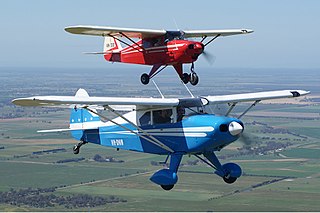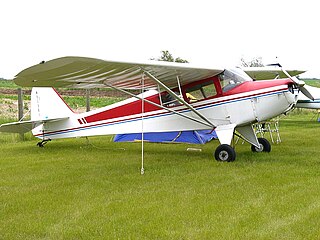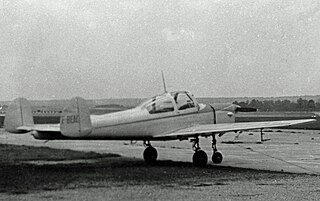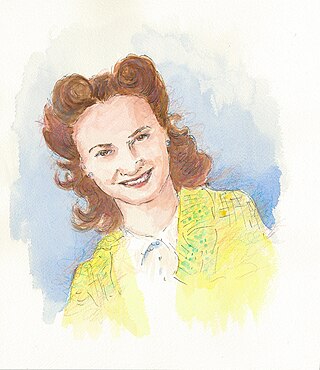
The ERCO Ercoupe is an American low-wing monoplane aircraft that was first flown in 1937. It was originally manufactured by the Engineering and Research Corporation (ERCO) shortly before World War II; several other manufacturers continued its production after the war. The final model, the Mooney M-10, first flew in 1968 and the last model year was 1970. It was designed to be the safest fixed-wing aircraft that aerospace engineering could provide at the time, and the type continues to enjoy a faithful following.

The PA-20 Pacer and PA-22 Tri-Pacer, Caribbean, and Colt are an American family of light strut-braced high-wing monoplane aircraft built by Piper Aircraft from 1949 to 1964.

The Taylorcraft B is an American light, single-engine, high-wing general aviation monoplane, with two seats in side-by-side configuration, that was built by the Taylorcraft Aviation Corporation of Alliance, Ohio.

The Piper J-4 Cub Coupe is a two place side-by-side version of the Piper J-3 that was built between 1938 and 1942 by Piper Aircraft. It was Piper's first model with side-by-side seating; combined with docile low-speed handling, this made it a good trainer.

The Oberlerchner JOB 15 was an Austrian two-seat light aircraft produced by Josef Oberlerchner Holzindustrie, which had previously designed and built gliders.

The Call-Air Model A is an American two- to three-seat utility aircraft designed by the Call brothers and built by the Call Aircraft Company, later developed into a successful line of agricultural aircraft.

The MBB 223 Flamingo was a light aircraft developed in West Germany in the 1960s in response to a competition for a standard trainer for the country's aeroclubs. Designed by SIAT, it was a conventional low-wing monoplane with fixed tricycle undercarriage. The cockpit was enclosed by a large bubble canopy. SIAT had not undertaken much production of the type before the firm was acquired by MBB in 1970. Eventually, the new owners transferred production to CASA in Spain.

The DINFIA IA 45 Querandi was a 1950s Argentine twin-engined light transport aircraft built by the DINFIA.

The Funk Model B was a 1930s American two-seat cabin monoplane designed by Howard and Joe Funk. Originally built by the Akron Aircraft Company later renamed Funk Aircraft Company.

The Hindustan Aeronautics HA-31 Basant is a 1970s Indian agricultural monoplane built by Hindustan Aeronautics.

The Piper Aerostar is an American twin-engined propeller-driven executive or light transport aircraft, designed by Ted R. Smith. It was originally built by Ted Smith Aircraft Company, which after 1978 became part of the Piper Aircraft Corporation.

The Max Holste MH.52 was a 1940s French-built two-seat touring or training monoplane designed and constructed by Avions Max Holste.

The Lake Buccaneer is an American four-seat, light amphibious aircraft derived from the Colonial C-2 Skimmer, itself a development of the three-seat Colonial C-1 Skimmer.

The SIAI-Marchetti S.210 was a 1970s Italian twin-engined cabin-monoplane designed and built by SIAI-Marchetti as a development of the single-engined SIAI-Marchetti S.205.
The Neiva Campeiro is a Brazilian two-seat utility monoplane built by Indústria Aeronáutica Neiva for the Brazilian Air Force. The Campeiro was based on the earlier Neiva Paulistinha 56 with a re-designed structure and powered by a 150 hp (112 kW) Avco Lycoming O-320-A piston engine. The Camperiro was a braced high-wing monoplane with a fixed tailwheel landing gear. Twenty aircraft were built for the Brazilian Air Force as the L-7 Campeiro and were used for liaison, observation, rescue and training.

The Stout Skycar was a series of four one-off American light aircraft of the 1930s.
The Eshelman FW-5 was a 1940s American experimental cabin monoplane designed and built at Dundalk, Maryland by the Cheston L. Eshelman Company.
The FLUGWAG Bremen ESS 641 was a 1970s German glider-towing monoplane designed and built by the Flugwissenschaftliche Arbeitsgemeinschaft Bremen research organisation.

The Speedtwin E2E Comet 1, originally named the Phillips ST1 Speedtwin, is a two-seat, twin engined aircraft designed in the UK to be capable of aerobatics and the only civil twin certified for intentional spinning. After a long development time, just two have been built.

Alverna Babbs Williams was the first American pilot with disabilities to earn a pilot's license.

















